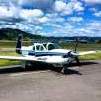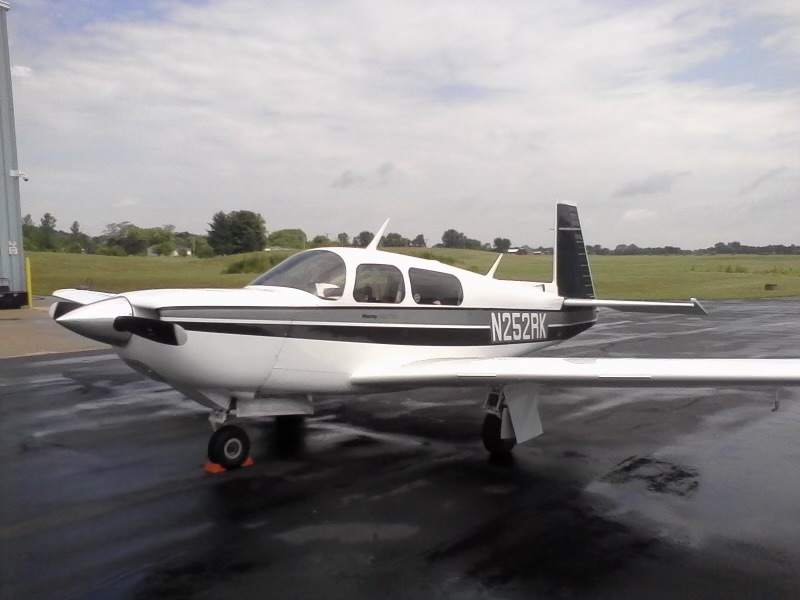-
Posts
5,482 -
Joined
-
Last visited
-
Days Won
25
Content Type
Profiles
Forums
Blogs
Gallery
Downloads
Media Demo
Events
Everything posted by Ragsf15e
-

Battery losing charge problem
Ragsf15e replied to Wojciech Kacprzyński's topic in Modern Mooney Discussion
The older ones (not sure if this includes yours) have the field wire switched with the master switch (the master is single throw, dual pole). So it provides neg to the madter solenoid and connects the field wire. Cessna and others provided those split switches we’ve all seen. I doubt this has anything to do with his issue unless his master solenoid isn’t shutting off. -

Battery losing charge problem
Ragsf15e replied to Wojciech Kacprzyński's topic in Modern Mooney Discussion
I’m no EE, but if your master solenoid is working, then the only draw can come from anything attached to the hot terminal on it (or hot wired to your battery). With your master off, the solenoid shouldn’t allow power to the main bus. That should be obvious. After that, you’ll need to check anything on the hot terminal or hot wired to the battery. There’s a light in the cabin/baggage that is on the hot terminal that has got many people. Maybe @PT20J could help? -

SCAM Avionics and aviation items … please be careful
Ragsf15e replied to stormflyer's topic in General Mooney Talk
It was said sarcastically, but I don’t feel like we treat these “minor” offenses as offenses anymore. Maybe we never did? -
As long as you’re high enough to cruise below about 75% power, you can just leave wide open throttle and reduce rpm to desired (I use 2500). Somewhere around 6500’ or so, check your poh. If you live somewhere low and want to cruise at 2500’, you’ll want to reduce mp and rpm to avoid running the engine really high power for a long time. Lycoming recommends 75% power or less during cruise for maximum longevity. You’ll likely want to be ROP in a C but LOP may be possible with a monitor.
-
This is actually key. I had some idiot (another USAF pilot) actually step on my flap to climb up and look in. Funny that I needed the SB to reinforce the cracked flap/spar connection that year?! My kids are experts and will never step on an airplane control surface!
-

SCAM Avionics and aviation items … please be careful
Ragsf15e replied to stormflyer's topic in General Mooney Talk
I wish society could catch these guys and offer some jail or at least community service no matter if they’re stealing stuff to sell or just trying to get cc numbers. Either way it should be a crime again. -
I have an engine monitor, so I can see all 4 chts exactly, but here’s a general observation that might apply… especially when flying in warmer air at higher power (but can also help up higher when thin air doesn’t cool as well too), slight changes in mixture can make a big difference in cht. Say I’m cruising at 9500’ in warm air like last weekend. I set up ~90 ROP based off my leanest cylinder. Im just above 65% power. I notice #3 cht is about 385. I turn mixture slightly richer and bring down EGTs maybe 10 degrees. The cht slowly cools to 370. LOP it’s even more sensitive. So maybe just try a smidge richer (or leaner if LOP) since it’s impossible to tell where you are running without a monitor. How do you know you’re ROP and how far? Just based off the single egt?
-
No tools, only a large and colorful vocabulary required to remove the back seats of my ‘68 f. They do have a recline mechanism, but it doesn’t move them much.
-
They actually look pretty good too! Good tread, no sidewall issues, etc. I just thought it was my exceptional landings? But yes, the previous owner was nice enough to put the $$ Goodyear tires on it. It’s hangared too so that probably helps.
-

Climb Performance- POH Also Optimistic?
Ragsf15e replied to 802flyer's topic in Vintage Mooneys (pre-J models)
Yeah that could be close on a warm day with a heavy airplane, but doable light and cool. If you are having to use Vx climb for ~2000’ ifr though, that brings up some additional thoughts… -

Climb Performance- POH Also Optimistic?
Ragsf15e replied to 802flyer's topic in Vintage Mooneys (pre-J models)
Did you have any “special friends” on board? Weight is a big factor, but middle weight, mine would be about the same. -

Climb Performance- POH Also Optimistic?
Ragsf15e replied to 802flyer's topic in Vintage Mooneys (pre-J models)
Full rich and 2700rpm you can likely climb a few thousand feet at Vx or Vy, but watch the CHTs. Do you have an engine monitor with 4xegt and 4xcht? At Vx and Vy on warm days cooling becomes a problem. 120mph works better but obviously avoiding your “mountains” is your priority. Best angle is at Vx with flaps and gear up. Lots of folks do not use flaps on takeoff, so that’s worth trying too. -
Ha, Good idea! I didn’t think about flipping them around! Thanks for the idea, Drew
-
I have had my main tires at least since I bought the airplane, so 8+years and ~800 hours. They look in reasonable condition except the left tire is starting to wear more on the inside half - closest to the cockpit. Ie away from the gear door. I’m not sure if it’s new or just enough that I finally noticed. It’s like the tire is slightly tilted with gear rolling on the ground, but it looks relatively straight from the front. Is there a way to adjust the tire or gear to get it level and to even out the tire wear?
-

Climb Performance- POH Also Optimistic?
Ragsf15e replied to 802flyer's topic in Vintage Mooneys (pre-J models)
You guys are light and pack well! -

Climb Performance- POH Also Optimistic?
Ragsf15e replied to 802flyer's topic in Vintage Mooneys (pre-J models)
Many of us are going to climb faster ias than Vy for cooling which reduces the fpm. I do agree with @Shadrach that starting from a SL standard day at light weight and 2700 rpm, >1000fpm is achievable through at least 5000’ at Vy. -

Climb Performance- POH Also Optimistic?
Ragsf15e replied to 802flyer's topic in Vintage Mooneys (pre-J models)
My ‘68 F can get to ~1000 fpm only at sea level, cool conditions, and “middle” weight. Typically the DA is ~3000’ where i fly and your numbers seem normal. When I fly at ~2600lbs, 3000’ DA, I’m looking at 600-700fpm. Here’s something though, weight is going to be a huge factor in climb. You said 2300lbs in your initial post… that’s 440lbs below gross. There will be a significant difference between 2200 and 2600lbs. You will find weight is a huge factor in speed as well. 100lbs will change your TAS by a couple knots. I also didn’t see if you leave 2700rpm. That helps a lot. -
I look carefully through the fuel pressure, fuel flow and EGTs during that time to see if you can identify exactly where it happens, then look at all the other parameters. Most of them (CHT, Oil temp, etc) won’t change fast enough to capture a hiccup.
-
Interesting. The AIM (and reg 91.209) says to have them on at all times unless they will “adversely affect the vision of other pilots or ground personnel. “ You could definitely be right and both the AIM and Reg give you the option to turn them off. Others don’t typically bother me (except at night), so I leave them on anytime I’m running the engine or planning to during the day. AIM: https://www.faraim.org/faa/aim/225/aim-225.html
-
At night I think that’s true, but I don’t think they’re a problem in the daytime unless you’re staring at my wingtip? You think so? I guess I don’t think they’re blinding in peripheral vision like at night?
-
Do you leave your strobes on all the time? Or maybe beacon or nav lights if no strobes? I definitely have a healthy fear of leaving my master on in some very hot, dry, remote place with my 6 year olds salty and tired. I try to tell myself that I’ll notice the strobes while I’m tying it down, but maybe not?
-
Unfortunately, I don’t.
-

Carbon Monoxide incident - Mooney No longer Stranded
Ragsf15e replied to JohnB's topic in Mooney Safety & Accident Discussion
Yes, it’s supposed to be recertified ~18-24 months. Mine is about that old. Still seems to be fine, but I think you can send them in for “factory overhaul “. -

Carbon Monoxide incident - Mooney No longer Stranded
Ragsf15e replied to JohnB's topic in Mooney Safety & Accident Discussion
I have the older pro version and it’s great. I have it hung on my old “microphone clip” which is in my line of sight. The alarm is loud but not through noise canceling headsets. Expect to see some low values on the ground and maybe during climb (<20) but zero in flight. -

Carbon Monoxide incident - Mooney No longer Stranded
Ragsf15e replied to JohnB's topic in Mooney Safety & Accident Discussion
Sensorcon is a good choice. There’s probably a discount available as well @DanM20C may know. It goes from 0 to 2000. https://www.amazon.com/Carbon-Monoxide-Inspector-Detector-Portable/dp/B004YUEPBW/ref=asc_df_B004YUEPBW/?tag=hyprod-20&linkCode=df0&hvadid=312140380281&hvpos=&hvnetw=g&hvrand=15002458341707748687&hvpone=&hvptwo=&hvqmt=&hvdev=m&hvdvcmdl=&hvlocint=&hvlocphy=9032382&hvtargid=pla-569992736801&psc=1




